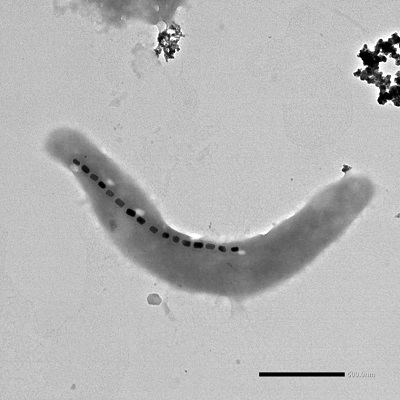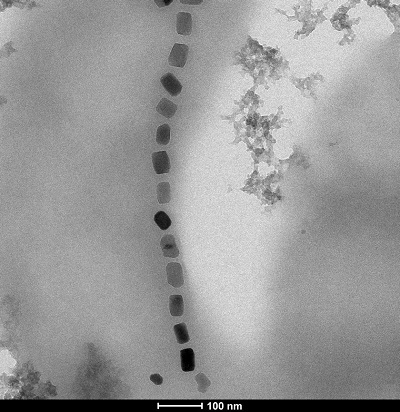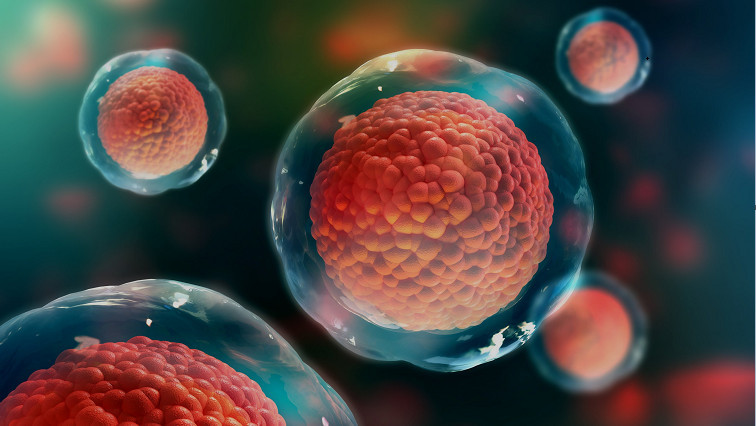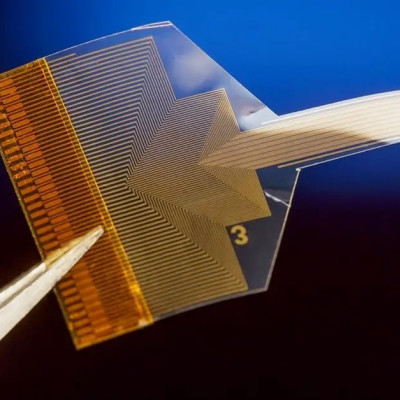Imagine a tiny vehicle with a nanomagnetic structure, which can be steered through the human body via external magnetic fields. Arrived at its destination, the vehicle may release a drug, or heat up cancer cells without affecting healthy tissue. Scientists of different disciplines are working on this vision to come true. A multidisciplinary research group at Universidad del País Vasco, Leioa, Spain, explores the talents of so-called magnetotactic bacteria, which have the surprising property to form magnetic iron oxide nanoparticles inside their cells. These particles, with diameters of around 50 nanometers (100 times smaller than blood cells), arrange, within the bacterium, into a chain. The Spanish team is pursuing the idea of using such "magnetic bacteria" as magnetic hyperthermia agents to treat cancer: Steered to the cancer site, the magnetic nanostructures are to be heated by external fields in order to burn the cancer cells.

TEM image of a M. blakemorei MV-1 bacterium with several magnetic nanoparticles forming a chain-linke structure. The scale bar is 500 nanometers.

The nanoparticles have a specific geometric form, shown by the TEM image. The scale bar is 100 nanometers.
Now, they have cooperated with a team of physicists led by Sergio Valencia at HZB to explore their magnetic properties in detail. The degree of success for all these applications depends sensitively on the magnetic properties of the individual nanomagnets. But since the signals originating from these super tiny magnetic structures are quite weak, it is necessary to average values over thousands of such structures in order to get meaningful data.
Average values are not enough
Until now, only these averaged values can be measured, which puts some constraints in the design of customized nanomagnet applications. But this has changed. Spanish physicist Lourdes Marcano has developed a new method during her postdoctoral stay in the team of Valencia at BESSY II: "We can now obtain precise information on the magnetic properties of several individual nanomagnets in a simultaneous way" she says.
Magnetic anisotropy for every single particle
The method allows to measure magnetic properties of individual magnetic nanostructures, even when embedded within biological entities. Magnetic imaging at the scanning transmission X-ray microscope MAXYMUS at BESSY II with the help of theoretical simulations permits to obtain information about the so-called magnetic anisotropy of each single nanoparticle within the field of view of the microscope. The method has been proven by determining the magnetic anisotropy of magnetic nanoparticles inside a bacterium. The magnetic anisotropy is an important parameter for controlling and steering magnetic nanoparticles as it describes how a magnetic nanoparticle reacts to external magnetic fields applied at an arbitrary direction.
Future standard lab technique
"Actually, magnetic imaging of magnetic nanoparticles inside a biological cell with enough spatial resolution requires the use of X-ray microscopes. Unfortunately, this is only possible at large scale research facilities, like BESSY II, providing sufficiently intense X-ray radiation. In the future, however, with the development of compact plasma X-ray sources, this method could become a standard laboratory technique," says Sergio Valencia.
Read the original article on Helmholtz-Zentrum Berlin (HZB).







